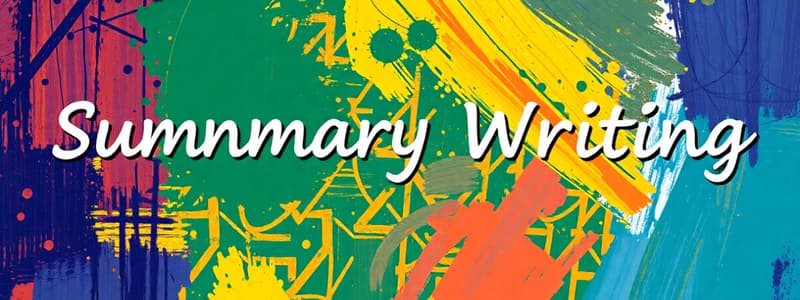Podcast
Questions and Answers
Why is it important to carefully read the text multiple times when summarizing?
Why is it important to carefully read the text multiple times when summarizing?
Careful reading ensures a comprehensive understanding of key points and issues, allowing for accurate summarization.
What are the key components to consider when developing the content of a summary?
What are the key components to consider when developing the content of a summary?
One should separate details from abstractions and trace the structure of the argument including the thesis and major divisions.
In what ways can further research enhance the summarization process?
In what ways can further research enhance the summarization process?
Further research provides broader context and deeper understanding, situating the summary within the larger academic debate.
What is the significance of recognizing the structure of an argument in summarizing effectively?
What is the significance of recognizing the structure of an argument in summarizing effectively?
How can one evaluate the reliability of sources when conducting further research?
How can one evaluate the reliability of sources when conducting further research?
Why is summarizing an important academic skill?
Why is summarizing an important academic skill?
What are two primary audiences for which summaries are written?
What are two primary audiences for which summaries are written?
What key features should effective summaries include?
What key features should effective summaries include?
How can the structure of a summary vary?
How can the structure of a summary vary?
What does it mean to respond to a text in summary writing?
What does it mean to respond to a text in summary writing?
What is the goal of a summary?
What is the goal of a summary?
Why might summary patterns be considered flexible guides?
Why might summary patterns be considered flexible guides?
How do summaries contribute to your own research?
How do summaries contribute to your own research?
Why is summarizing an important skill in academic and professional writing?
Why is summarizing an important skill in academic and professional writing?
What are the key elements that should be included in an effective summary?
What are the key elements that should be included in an effective summary?
How can critical thinking enhance the summarization process?
How can critical thinking enhance the summarization process?
What strategies can be employed when responding to a text?
What strategies can be employed when responding to a text?
What role does understanding both 'looking at' and 'looking through' a text play in summarization?
What role does understanding both 'looking at' and 'looking through' a text play in summarization?
In what ways can summarizing improve one's writing skills?
In what ways can summarizing improve one's writing skills?
Why is it important to evaluate the author's authority and emotional appeal when summarizing?
Why is it important to evaluate the author's authority and emotional appeal when summarizing?
What elements constitute the structure of a strong summary?
What elements constitute the structure of a strong summary?
Flashcards are hidden until you start studying
Study Notes
Summaries
- A summary is a brief but clear description of key content
- Summaries are essential for engaging in academic debate and current research
- Summaries are key to scholarly literature review
- An abstract is a form of summary
Summary Audiences
- Summaries written for general audiences aim to inform readers about new publications or ideas
- Summaries written for academic audiences often include more details and citations
Summary Structures
- Summaries can follow the original structure of the article
- Summaries can be rearranged to compare/contrast ideas, highlight key points, or to avoid repetition
Summary Purposes
- To focus on major concepts
- To introduce the author’s perspective/stance and their connection to previous work
- To engage in scholarly conversation
- To shape the content of your own research
Developing Summary Content
- Carefully reread the text, finding the topic sentences of each paragraph
- Translate the original text into your own words
- Decide on the appropriate length and amount of detail
- Retrace the structure of the argument, finding the thesis statement, literature review, discussion, methodology, and major divisions of the paper or argument
- Conduct further research to get a better overview of the topic
- Include Internet searches, databases, print sources, and empirical sources
Strategic Reading and Critical Thinking
- Reading strategically means analyzing a text for its genre and key pieces of information
- Thinking critically means adopting an inquiring and skeptical stance towards the text
- Looking THROUGH a text means focusing on the content and understanding the main points
- Looking AT a text means exploring the author's choices in genre, persuasion strategies, style, and word choices
Responding With a Text
- Evaluating what others have written is more than simply agreeing or disagreeing
- Consider why people should care about what the author has written
- Identify where and why you find the author’s views compelling or not
- Incorporate the author's ideas into your own writing
Studying That Suits You
Use AI to generate personalized quizzes and flashcards to suit your learning preferences.



